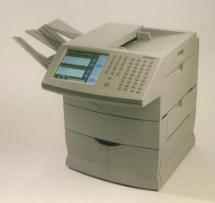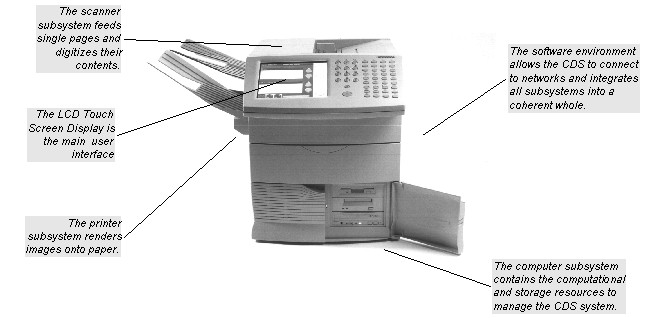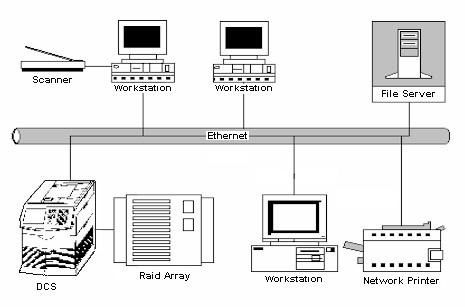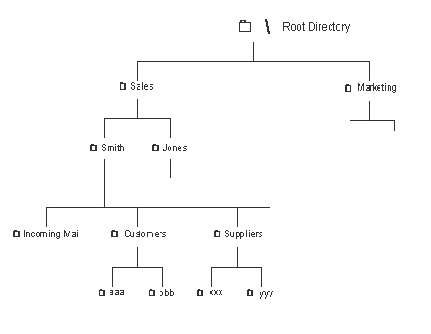


Cromemco Hellas A.E.
Σουλίου 1 & Λ. Πηγής , 151 27 ΜΕΛΙΣΣΙΑ -
Τηλ 210-



Product Information
Cromemco CDS
Document Server Series
The CDS Cromemco Document Server is the world's newest document storage and retrieval system. It is the first such office system to electronically store a true image of office documents and then be capable of retrieving a true image of a desired document on demand. Most important, the CDS is a complete solution that addresses the scanning, storage, and retrieval needs of an office electronic document management system.
The CDS is designed to operate in a workgroup environment. In fact the CDS itself is a network server with a local area network connection. Any client in the network (Windows '95 or Windows NT workstation) can be used to search, retrieve, and display images of documents that have been scanned by the system. The retrieved document may then be printed out on the internal system laser printer, or any other network printer. The CDS includes both the server software and the client software for a complete document management solution.
The CDS server software adopts mainstream industry standards. The operating system is Microsoft Windows NT Server, and all document images, and indexing information, is stored in a Microsoft SQL database. Within the SQL database, documents are organized in folders and may be retrieved by the folder name. In addition, keywords may be added to any document or any folder, and retrieval may be by keyword.

The system is very easy to use. From any workstation, each user defines or selects the folders into which he or she wishes to scan documents. These folders are then displayed on the system front panel touch panel. All that is required to scan a document is to select a folder from the system touch panel, then press the green button to start the scan. No other action is required.
A unique feature is that documents can be scanned with high-
The system can typically be used to scan and store about a million document pages. About 100,000 pages can be stored on the system's internal disk drive. Additional external storage capacity can be connected to the SCSI port, or can be accessed anywhere on the local area network in order to store additional page images.
By adopting industrial standards the CDS easily meets particular customer requirements.
Instead of the standard Ethernet controller a FastEthernet controller can be used.
In fact every network controller with Windows NT support can be installed to integrate
the CDS into a network. The CDS and its clients can communicate via all network protocols
that are supported by Windows NT:, e.g. NetBEUI, TCP/IP, IPX/SPX. To ensure highest
data availability and security external RAID systems can be connected, or a Cromemco
FT-
Additionally Smith may assign keywords to the document which specify its content. Later this document can be retrieved either by specifying its name, by specifying its keywords or a combination of both.
The following figure shows a typical network configuration:

Technical Specifications
Computer
CPU
Dual Pentium
Operating System
Microsoft Windows NT Server
Database System
Microsoft SQL
RAM Memory
64 MB expandable to 256 MB
Hard Disk
4 GB -
Tape Drive
4 GB -
CD-
600 MB capacity
Diskette
1.44 MB Floppy
User Interface
Color LCD Touch Panel
Scanner (internal)
Resolution
400 dpi x 400 dpi, 10 ppm / 200 dpi x 200 dpi, 20 ppm
Gray Scale
256 levels or bitonal (selectable)
Scan Accelerator
JPEG micro-
Image Store Format
JPEG or TIFF
Paper Feed / Feeder Input Tray
Automatic Document Feeder 50 sheets capacity
Paper width / length
5,8" -
Scanner (external)
Format
up to A0
Interface
TWAIN or ISIS

Printer
Network
Client requirements
Miscellaneous
Resolution
400 dpi x 400 dpi, 4 ppm
Technology / Print Accelerator
Laser / JPEG micro-
Main Paper Tray
500 sheet capacity A4 or letter size
Auxiliary Paper Tray
100 sheet capacity A4, letter, or legal size
Technology
Ethernet 10baseT or Thinwire
Communication Speed
10 Mb/sec
Operating System
Windows '95 or Windows NT
RAM Memory
16 MB minimum recommended
Dimensions / Weight
16" W x 23" D x 20" H / 80 lbs.
Power
220 VAC, 800 Watt max.
All Trademarks acknowledged.
Technical Specifications are subject to change without notice.
© Cromemco MPCT GmbH, 07/97
This diagram shows a typical folder organization. Each department in a company has
its own folder under the root directory \, e.g. the sales and the marketing department.
Each employee in the specific department also has his own sub-
from his incoming folder to its destinations, e.g. correspondence with the supplier xxx into the folder \Sales\Smith\Suppliers\xxx.